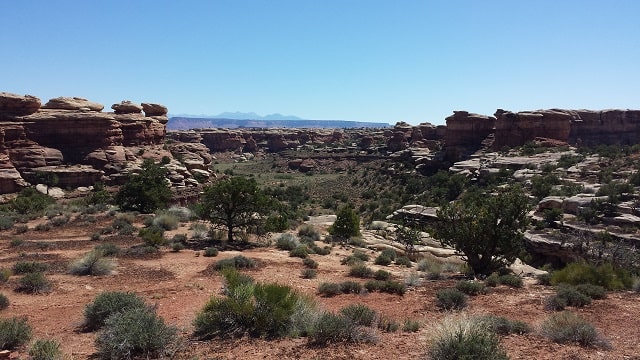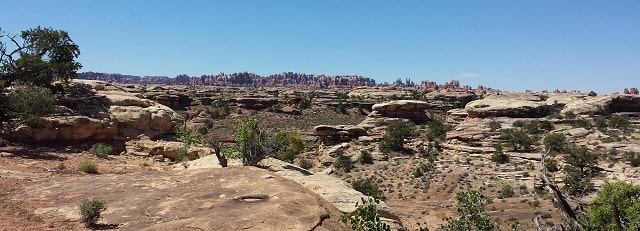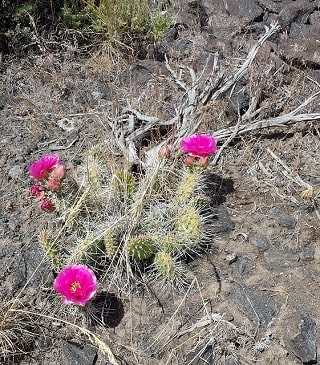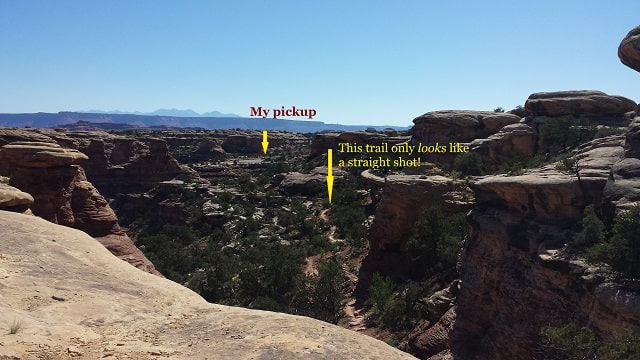
Ever find yourself doing something stupid, but pride — or sheer stubbornness — makes you keep going despite your better judgement? Yeah, me, too. Those kinds of mistakes can be deadly. But they can also turn into valuable lessons, and be the source of unexpected Grace. I’ll explain what I mean with the tales of two hikes.
Canyonlands, Utah, 2015
A few years ago, I was on vacation and decided to check out the Canyonlands National Park in Utah. For those of you unfamiliar with the area, the Park consists of several canyons cut through the Utah desert by the Colorado River and its tributaries, notably the Green River.
The northern portion of the Park, called Island in the Sky, is easy to take in by vehicle. A nicely paved road wanders the spine of a plateau, meandering to the edge here and there for gorgeous views of a remarkable landscape. It made for a nice day of sightseeing from Moab, Utah.
The southern portion of the Park, called The Needles, is quite different. Thanks to the Colorado River itself, you can’t just drive straight through from Island in the Sky. In fact, the main entrance for The Needles is 35 miles from the highway between Moab and Monticello, UT.
[Note: There are two other sections, Horseshoe Canyon and The Maze, which involve even longer drives on dirt roads from the town of Green River, UT. Not on my itinerary.]
The day I went to the southern portion called The Needles, I decided I wanted to day hike. This in and of itself wasn’t the problem. No, several decisions on my part made life a lot more “interesting” than it needed to be.
First of all, being on vacation, I didn’t set my alarm for an early morning start. Dangerous in hot country.
Second, it took much longer to get to the Park entrance and Ranger station than I anticipated. I wanted to talk to the staff about of couple of the trails and was glad I did. One dirt road loop I had considered was out of the question. After discussing the trail from the Big Spring Canyon Overlook road to the confluence of the Green and Colorado Rivers, I decided to hike in from there.
She asked me a few questions, like: Did I have plenty of water? Did I have problems
with climbing ladders? Otherwise, she said it was fairly moderate. Ready for my 10 mile round trip hike (estimated 4-6 hours), I took off.
My preparations turned out to be minimal, and that was my third mistake. None of the maps I had looked at nor my discussion with the Ranger had adequately described the hike I was about to embark on.
Reaching the trail head between 9 and 9:30 am, I loaded up my pack with water, trail food and my usual hiking essentials and took off.
The trail started by descending into a narrow canyon and up again. Rounding a shoulder, it descended again, then zigzagged up to a rock face with an iron ladder. The ladder itself was fine. The long steps around and on boulders to get to and off it were another thing. I’m 5’1”. My legs didn’t want to stretch that far. But I made it and continued on.
Things got better for a while, crossing a relatively flat area before descending and ascending another canyon. But of course, it also got hotter.

I finally reached a ridge where I could look down at the dirt road that went almost to the overlook. I stopped in the shade and small breeze for lunch and considered. I was hot and tired. It was already past 1 pm and I still hadn’t reached the confluence. Sore and scraped up from scrambling even more boulders that were taller than me (who built this trail, anyway!), I seriously thought about just turning around and heading back. A few vehicles went by on the road as I rested, and I thought to myself that maybe I should have opted for the drive even if I couldn’t go on the narrow part I wanted to. Too late now.
I wasn’t more than a mile from the overlook, and I’d already come this far; I’d always wonder if I didn’t try it. So, I continued on. Mistake number four.
I reached the Confluence Overlook and took a few pictures. It was beautiful in a stark, rocky desert way, seeing the water coming together from two canyons, one river tinged greenish-beige and one a darker tan from the sediments they carried. The waters from the two traveled side-by-side before they started to mix at the next turn.
Heading back to the parking area at the end of the dirt road, I sat at a picnic table in the shade and took stock. I was OK on food, but nearly out of water. It had taken longer to get here than expected, and I had grossly underestimated my water needs, even if I had brought twice as much as I thought I’d require. Maybe I could hitch a ride back with someone driving in?
Instead of the trail, which went straight over a low, grassy ridge, I opted to take the road around the ridge, accepting the trade-off of an extra 1/3 mile or so on even ground, hoping to meet someone. No one came. When I got to the trail again, I worked my way up the next ridge.

Back where I had eaten lunch, I stopped to rest and drink some of what little water I had left. And promptly vomited.
This was not good.
I was in deep trouble, and I knew it. Both heat stroke and heat exhaustion can lead to vomiting. Many of the other signs were there as well but could have been attributed to the exercise: flushed and lots of sweating (I always do that); muscle aches and fatigue (ditto); headache (heat). But I couldn’t excuse away the vomiting.
I rested, trying to think things through. I figured I had four choices: wait for someone to come along; go back to the road and wait for someone; just keep going. It was already late afternoon, so someone coming along was unlikely. The fourth choice? Stay and give up.
The last one was temping — real tempting. I was tired. Oh, so tired! I’d lived a pretty full life, was near 60, my faith in God was strong, and I wasn’t afraid of death. I had screwed up, miscalculated, and now I had to pay the price. It was a gorgeous place to say good-bye. My husband could go on, right? My dog Missy would get over it; she was a dog, after all.
During my deliberations, I drifted in and out as I nodded off from fatigue. Coming back from one nap, I was coherent enough to realize my thinking wasn’t at all clear. And I realized how unfair it would be to my husband to give up without trying. He loved me, and he would be devastated. I loved him in turn. Giving up wasn’t an option. How had it come to this? I knew better; I’d been through something like this before.
Hell’s Canyon of the Snake River, Oregon, 1980
In 1979, while on a college geology class field trip, a bunch of us hiked from Hat Point to the bottom of Hell’s Canyon of the Snake River. Considered the deepest gorge in the U.S., it’s not as wide as the Grand Canyon of the Colorado, and the trail was much rougher and steeper, since it was mostly game trail. It was supposed to take about 4 hours round trip. A great picture from Hat Point by Greg Vaughn can be found here.

The three best hikers in the class were down to the bottom and back, meeting our group before we were even half-way down. We had four experienced hikers and six who weren’t, including one in sandals and another in flip-flops, and most in tennis shoes. I was younger and in much better shape back then, yet I still battled the heat. It was enough that when we reached the river, I managed to sit on a rock with a cactus growing behind it!
While a classmate used my Swiss Army Knife tweezers to get the spines out of the back of my rear, his girlfriend distracted me by talking about the trip back. A plan was devised. We took inventory of what we had for food, water and other supplies (not much), divvied up a few things, then herded the rest for the trip back up.
I led off, my short legs not going fast, but I can get a groove and go steady. The most fit of us brought up the rear, and we spread the rest between us and the other two experienced folks. It was almost full dark by the time we reached the creek in a small meadow we considered the half-way point. The rest of the food was eaten, and everyone had water and a good rest. We continued on with two flashlights.
The upper stretch was in conifer trees, and it was dark. My night vision had adapted enough to see the slightly lighter trail by the time the flashlight died, but it was getting harder to coax folks along. I had the girl behind me hang on to my waistband. We had to keep rest stops short to keep people from getting chilled in the desert night, but there were many complaints and requests to “leave me behind”. We didn’t.
Hours later, we saw flashlights coming down towards us. Help had finally arrived — not! They were smoke jumpers stationed next to where we were camped. Having heard there were girls in our group, they were looking for a little action, and maybe someone to smoke a joint with. By now, even those who might have been interested only wanted to crash on their own sleeping bags. So, the three guys left us behind and went back up the trail to their camp.
At least we knew we were close. By 11:45 pm we staggered into our camp.
Besides having no choice but to laugh at getting cactus spines pulled from my butt and sharing with everyone else the misery of poison oak from our rest at the creek, I thought I’d learned two important lessons from that experience: 1) Be prepared for anything; 2) I can be downright determined and stubborn when I need to be.
Back to Reality, 2015
Yet here I was, 35 years later, in almost the same predicament: inadequately prepared and in trouble. But this time I was alone.
“OK, God,” I prayed, “It’s you and me. We did it once before; please help me get back to the car.” I took a small sip of water that stayed down, got to my wobbly feet and started down the trail.
One of the tricks I’d used on the first hike which I employed again, was to sing a little song in my head to keep my pace. On that long-ago hike, the ditty was from 2nd Corinthians 9:12, “My grace is sufficient for you, for my power’s made perfect in weakness.” I felt plenty weak, so I started with that. It was a mantra, helping to focus on the trail in front of me, putting one foot in front of the other.
Whenever I started to give up, I reminded myself of my husband, of how much we loved each other, and of how I wanted to spend many more years with him. And I’d go back to one step at a time.
Finally, I reached the ridge with the ladder, and I could see the parking lot and my car. Hurray! It was after 6 pm now, and the valley was in shadow, but higher spots including the road were still in sunlight.
Now I started meeting people. Mostly folks who’d waited until things cooled a bit and were just going to the ladder ridge and back. Reaching the narrow gulch bottom, I crossed the dry stream bed and stopped to breathe before tackling the next ascent. A guy coming my way stopped and looked at me.
“Would you like some water?”
I looked at him and his pack. He was ready for the back country, probably planning to dry camp and go on to the river via another trail. There was no water for him until sometime tomorrow.
“No, that’s OK. I’m almost to my car.”
“I have plenty. Really.”
I wasn’t sure, but I thought it’d been at least two hours since I’d finished my last sip. I looked at him watching me, and realized I was acting stupid again.
“Well, OK, thank you.”
I carefully took a few swallows, thanked him again, and started up. Good thing I’d accepted his gracious offer: I’d forgotten there was a small ridge to climb and another gully before the final climb to my truck.

I cranked up the air conditioning and carefully drank some water. When I felt steady enough, I drove to the ranger station. Getting out, I promptly threw up again. They were closed, but the drinking water station was accessible. I wiped my head and neck with wet paper towels, filled my empty bottle with cold stuff, and managed to get some down that stayed.
As soon as I had cell service, I texted my husband that I loved him and was on my way to the hotel and would call tomorrow.
Conclusions, the Present
I haven’t told my husband how close I came to packing it in that day. It scared me then, and it scares me now. I suppose the guy who gave me water near the end might have found me if he stayed on that trail. But in what shape? I later learned that I was probably an un-diagnosed Type 2 Diabetic at the time, which made the overheating both easier and more dangerous, and my high-calorie trail food wasn’t helping.
But I did make it. Even alone, without others to encourage me or for me to feel responsible for. My stubbornness, determination, tenacity — whatever you want to call it — is a two-edged sword. It can get me into trouble, and it can get me out of it. Life would be a lot easier if I avoided that first edge.
Yet, I sometimes wonder if, had I not experienced the first hike, would I have made it through the second?
While not all the challenges I face are this dramatic, I can also look at these experiences and realize that the same determination can get me through a pandemic, an economic downturn, and whatever else is thrown my way. As long as I couple it with clear, non-emotional thinking to move me in the right direction. And prayer (mindful thinking for you non-religious) to keep me focused and remind me I am loved.
And I in writing this, I realized that Grace must be received to be appreciated. The hiker who gave me water was as much the gift as the water. He saw a need and acted on it, and I was almost too stubborn to accept. How often have I let pride get in the way of receiving a few sips (or a cup) of Grace? What about you?
Grace, Peace and Hugs!
P.S. I did climb a 500 ft ridge at altitude in Colorado this June. And turned back rather than continue on the rocky spine. Old dogs can learn new tricks!
Hi Marty, Catching up on old posts. Good story, good story-telling, good message.
Thank you!